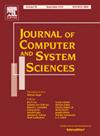具有大小约束的分类聚类的参数化复杂度
IF 0.9
3区 计算机科学
Q1 BUSINESS, FINANCE
引用次数: 0
摘要
在范畴聚类问题中,我们给出了∑m上的一组向量(矩阵)a={a1,…,an},其中∑是有限字母表,以及整数k和B。任务是将a划分为k个聚类,使得Hamming范数中聚类的中值目标至多为B.Fomin,Golovach,和Panolan[ICALP 2018]证明了该问题对于二进制情况∑={0,1}是可处理的固定参数问题。我们将该算法结果扩展到一个流行的容量聚类模型,其中聚类的大小分别由整数参数p和q的下界和上界。我们的主要定理是这个问题在时间2O内是可解的(博客B) |∑|B·(mn)O(1)。本文章由计算机程序翻译,如有差异,请以英文原文为准。
Parameterized complexity of categorical clustering with size constraints
In the Categorical Clustering problem, we are given a set of vectors (matrix) over , where Σ is a finite alphabet, and integers k and B. The task is to partition A into k clusters such that the median objective of the clustering in the Hamming norm is at most B. Fomin, Golovach, and Panolan [ICALP 2018] proved that the problem is fixed-parameter tractable for the binary case . We extend this algorithmic result to a popular capacitated clustering model, where in addition the sizes of the clusters are lower and upper bounded by integer parameters p and q, respectively. Our main theorem is that the problem is solvable in time .
求助全文
通过发布文献求助,成功后即可免费获取论文全文。
去求助
来源期刊

Journal of Computer and System Sciences
工程技术-计算机:理论方法
CiteScore
3.70
自引率
0.00%
发文量
58
审稿时长
68 days
期刊介绍:
The Journal of Computer and System Sciences publishes original research papers in computer science and related subjects in system science, with attention to the relevant mathematical theory. Applications-oriented papers may also be accepted and they are expected to contain deep analytic evaluation of the proposed solutions.
Research areas include traditional subjects such as:
• Theory of algorithms and computability
• Formal languages
• Automata theory
Contemporary subjects such as:
• Complexity theory
• Algorithmic Complexity
• Parallel & distributed computing
• Computer networks
• Neural networks
• Computational learning theory
• Database theory & practice
• Computer modeling of complex systems
• Security and Privacy.
 求助内容:
求助内容: 应助结果提醒方式:
应助结果提醒方式:


